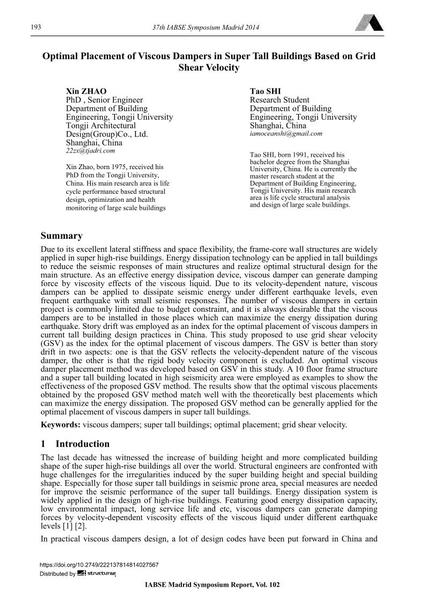Optimal Placement of Viscous Dampers in Super Tall Buildings Based on Grid Shear Velocity

|
|
|||||||||||
Détails bibliographiques
| Auteur(s): |
Xin Zhao
Tao Shi |
||||
|---|---|---|---|---|---|
| Médium: | papier de conférence | ||||
| Langue(s): | anglais | ||||
| Conférence: | IABSE Symposium: Engineering for Progress, Nature and People, Madrid, Spain, 3-5 September 2014 | ||||
| Publié dans: | IABSE Symposium Madrid 2014 | ||||
|
|||||
| Page(s): | 193-198 | ||||
| Nombre total de pages (du PDF): | 6 | ||||
| Année: | 2014 | ||||
| DOI: | 10.2749/222137814814027567 | ||||
| Abstrait: |
Due to its excellent lateral stiffness and space flexibility, the frame-core wall structures are widely applied in super high-rise buildings. Energy dissipation technology can be applied in tall buildings to reduce the seismic responses of main structures and realize optimal structural design for the main structure. As an effective energy dissipation device, viscous damper can generate damping force by viscosity effects of the viscous liquid. Due to its velocity-dependent nature, viscous dampers can be applied to dissipate seismic energy under different earthquake levels, even frequent earthquake with small seismic responses. The number of viscous dampers in certain project is commonly limited due to budget constraint, and it is always desirable that the viscous dampers are to be installed in those places which can maximize the energy dissipation during earthquake. Story drift was employed as an index for the optimal placement of viscous dampers in current tall building design practices in China. This study proposed to use grid shear velocity (GSV) as the index for the optimal placement of viscous dampers. The GSV is better than story drift in two aspects: one is that the GSV reflects the velocity-dependent nature of the viscous damper, the other is that the rigid body velocity component is excluded. An optimal viscous damper placement method was developed based on GSV in this study. A 10 floor frame structure and a super tall building located in high seismicity area were employed as examples to show the effectiveness of the proposed GSV method. The results show that the optimal viscous placements obtained by the proposed GSV method match well with the theoretically best placements which can maximize the energy dissipation. The proposed GSV method can be generally applied for the optimal placement of viscous dampers in super tall buildings. |
||||
